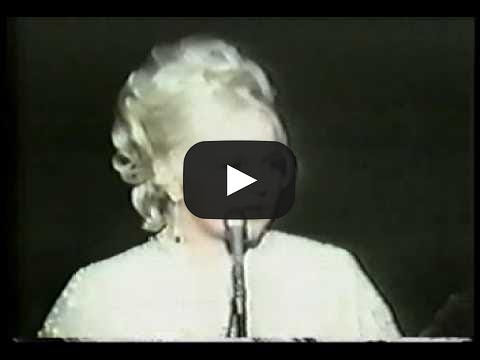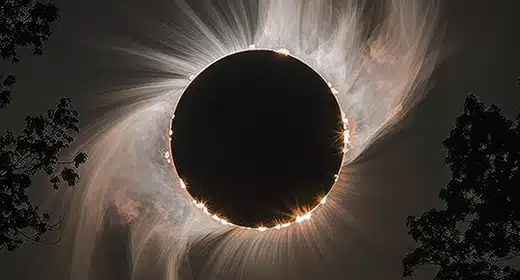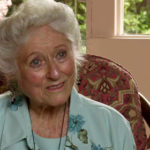by Ted Gioia: People often talk to me about music, so I’m not surprised when friends ask me about specific songs.
 But I found it uncanny—and actually unsettling—when two elderly individuals very close to me, both in poor health and near death, mentioned the same obscure song.
But I found it uncanny—and actually unsettling—when two elderly individuals very close to me, both in poor health and near death, mentioned the same obscure song.
These two individuals never met each other, and lived thousands of miles apart, but in their final days they both wanted to talk about the same record from more than fifty years ago. They told me that the lyrics of this pop tune captured their melancholy reflections on what had gone wrong in their lives.
The song in question, “Is That All There Is?” had been a modest hit for vocalist Peggy Lee in 1969, but never quite reached the top ten. I’m hardly surprised by that. It was the era of Woodstock and psychedelic rock, and a gloomy song of this sort had nothing in common with the upbeat youth movement that was defining the musical culture of the day.
The track is mostly a semi-spoken monologue, interrupted by sung interludes on the meaninglessness of life—capped by a complaint that “I’m not ready for that final disappointment.” I consider it the mirror image of Frank Sinatra’s “My Way,” a more successful hit of the same era, which celebrates a triumphant life full of victories and self-actualization.
If you never got the chance to do things your way, this is your song.
I can’t even begin to explain how sad I felt hearing people near and dear to me point to “Is That All There Is?” as a summation of where they had arrived in their last days. Yet I understood exactly what they were trying to say.
Psychologist Mihaly Csikszentmihalyi, an influential thinker who devoted his entire career to studying the pathways to happiness and a meaningful life, points out the huge gap between our desires for a coherent, purposeful existence and the jumble of disconnected and turbulent experiences that define our day-to-day realities. We seek a technique for, in his words, “cheating chaos.” But it almost seems as if the universe is conspiring against us.
In the course of intensive research into the lives of thousands of individuals, he heard again and again of their “intense desire to join all experience into a meaningful pattern.” But, he concluded, “frustration is deeply woven into the fabric of life.” Instead of a sense of purpose, they encountered only chaos.
I note in passing that “chaos” is a very fashionable scientific term these days, with rich implications in mathematics, physics, and a range of practical disciplines from stock market forecasting to traffic control. But it’s also a recurring concept in almost every ancient mythical or religious worldview.
And how do you combat chaos?
Many of these ancient stories point to music. For traditional societies, music wasn’t just idle entertainment, but a powerful tool in imposing meaning and coherence on our lives, both individually and communally. The song (Latin cantus) was nothing less than an incantation (incantatio)—literally a sound with transformative properties.
In ancient myths, we hear of the world literally being sung into being out of chaos, and that’s true whether we’re discussing the quasi-magical Songlines of Aboriginal culture in Australia or Shiva creating the universe, in Hindu iconography, with a damaru, an hourglass-shaped drum of tremendous antiquity, or a host of other mythic traditions.
But you don’t need to study ancient mythology to know this. We all have firsthand experience with music creating a fabric of meaning and coherence in our lives. There’s a reason why songs accompany every important gathering, holiday, ritual, and sacrament. There’s a reason why milestone moments in our personal history—from birthdays to marriages to last rites—each have their special songs. There’s a reason why every generation turns to music for a sense of identity and purpose, and historic moments in modern life get branded as, for example, the Jazz Age or the Swing Era or the Age of Woodstock.
They don’t teach these rituals in music class. They don’t mention them in harmony or musicology textbooks. But this music of personal transformation includes the most important songs we will ever sing or hear.
So I’m not surprised that Dr. Mihaly Csikszentmihalyi found himself turning to music when trying to learn how individuals created happy, purposeful lives out of the chaos of their daily existence. And he discovered that musicians have the rarest gifts of all: the ability to enter into the ideal mindset for optimal experience, a subjective state that he called flow.
In a flow state, the boundary between work and play disappears. Even difficult things are achieved with a sense of ease. We no longer struggle to find meaning or purpose in our activities—they just come to us, reliably and effortlessly, in a way that seems almost magical.
The etymology tells a deep truth here: the song (cantus) is a magical incantation (incantatio).
I experienced that myself in my mid-teen years when I started to make rapid strides as a pianist. At first, practicing the instrument was hard work, but then, over the course of months and years, something delightful began to happen. It wasn’t just that difficult passages were now easy to play. An even more extraordinary change took place. In the midst of an intense performance, the music seemed to be playing itself.
Even though my hands were making all the movements, some of them extremely complicated and at a very rapid pace, I didn’t have to think about them at all. I’ve never had a genuine out-of-body experience, but this came close. I almost felt as if I were an observer to the music-making, not an active participant. The joy of feeling this sense of control while also losing control is impossible to express in words.
 |
The author as a young jazz pianist: “There were moments when the music seemed to be playing itself.”
I’ve since heard many other musicians describe similar experiences of effortless mastery. Follow-up research by Csikszentmihalyi and others has shown the these flow experiences can be contagious. The different musicians in an ensemble pick it up from each other. The audience also gets caught up in the flow—they feel it emanating from the bandstand, and abandon themselves to its impulses.
This transformation can happen in the least likely situations. Research shows that teachers who achieve flow states—and not just during performance but merely in classroom activities—are more likely to impart a similar mindset to their students. In other words, musicians have special skills both as participants in these transformational experiences, and as conductors of them—mimicking the ancient literature to a striking degree.
Yet the whole institutional context in which music careers take place is perversely designed to thwart these capacities. When psychologists tried to measure the flow state at an actual music school they found that the imposed structure of student evaluations in high-pressure situations undermined the ability to enter into a flow state. The researchers sadly concluded that “most did not experience [performing] as absorbing or enjoyable.”
And even those who somehow manage to succeed in these music schools often discover, to their dismay, that this merely qualifies them for a career in which performance anxiety and fear of failing short of expectations follow them at every step. The negative cycle perpetuates itself.
I’ve experienced this, too, firsthand. As a young child, I hated piano lessons and the inevitable “recital for parents” that are the building blocks for music instruction almost everywhere in the world. I complained so vehemently to my parents, that they allowed me to stop music lessons entirely around age ten. But then, perhaps to my own surprise, I continued to play the instrument—for fun, I would have explained it at the time. Over the next few years, I had to overcome the negative conditioning of those formative experiences in order to discover my own inherent love of music-making. At age thirteen I sheepishly asked my parents if they would be willing to pay for a piano teacher, because I wanted to resume formal lessons.
The dysfunctional elements at work here are highly troubling—put simply, I could only discover my love of music by turning my back on how it is usually taught. And so many others have had similar experiences, and few recover sufficiently to return to formal study—let alone a professional music vocation as happened with me. But this isn’t a book on music education, so I can’t linger on this serious dysfunction in our schools and music lessons. But before moving on, let me point out the craziness of a process that supposedly supports our music ecosystem, while removing the single biggest reason for becoming a musician, namely its formidable power as a pathway to extraordinary experiences.
Those genuine experiences are the subject of this book.
How can music resist chaos? Much of this takes place in our brains, which seem to possess an extraordinary ability to differentiate between songs and noise. One scholar has gone so far as to declare that “your brain is like Beethoven”—seeking order and coherence in a manner that resembles the organizing principles in a musical composition.
Many ardent champions of modernism in music have praised the virtues of noise, going back at least to the 1913 Futurist manifesto The Art of Noises by experimental composer Luigi Russolo. But more than a century of painful experience, supported by clinical research, reveals an intense resistance among music lovers to chaotic music. Even infants show a marked preference for consonance rather than dissonance. But even more revealing are brain scans, which show that our responses to noise are fundamentally different from the ways we process music.
And while the biological advantages of music are too numerous to list here—I’ve written an entire academic book, entitled Healing Songs, on that subject—the organic impact of noise is less well known, but just as significant. Chronic exposure to noise is linked to hypertension, heart disease, depression, anxiety, and a range of other ailments and risk factors.
Here again, science confirms what traditional societies already knew long ago. The very word noise is etymologically linked to nausea—suggesting a biological connection between these cacophonous sounds and a disordered body.
On the other extreme, the highest sense of order in creation was described by the ancients as a musica unversalis or harmony of the spheres. The spheres in this instance were the celestial bodies, and this idea that they operated as a musical structure was more than just a metaphor. The stars and planets literally ran on music, the way a Tesla gets its charge from the power grid. And if this harmony could transform the celestial bodies, what might it do for our own terrestrial bodies?
Even more significant, for our purposes, are the surprising ways in which music resembles a journey—and though this too is a familiar poetic trope, the supporting evidence here too comes from a range of scientific studies. As early as 1934, neuroanatomist Andrew Arthur Abbie speculated on a “coordination between hearing and muscular movements” embedded in our neural pathways. This would explain the fact that “rhythmic movements in time to music have reached a high stage of expression.” In his view, our delight in human art was inextricably linked to a body moving in space.
I doubt that Bruce Chatwin was aware of any of this research when he wrote his evocative study The Songlines, which takes its name from those geographic pathways literally sung into existence by the ancestors of Australia’s aboriginal communities. But he was obsessed with the idea that human culture had been formed by early nomadic tribes, and as a result the necessities of arduous journeys became hardwired into our brains and bodies. In Chatwin’s view, this early history explains why babies like to be walked while parents sing to them—this preference is built into our central nervous systems over the course of countless eons. Even after we grow up, our body remembers a comforting connection between songs and a trip.
Perhaps that explains why musicians have so much trouble playing a song, even a familiar one, if they are asked to start in the middle. There’s something about the narrative structure embedded into our music that demands a beginning, a middle, and an end. Composers are well aware of this, and they work to accentuate these story-telling elements in their works, even if it’s a purely instrumental piece without words. The composition is expected to serve as a roadmap to a memorable journey, even if the audience remains seated throughout the concert.
But that insistence on staying motionless at the symphony hall is merely another measure of the dysfunctional rules of our dominant music institutions. Classical music actually originated in dancing. That’s even true for a composer as cerebral as Bach. He’s considered the most intellectual of composers, but he had a deep knowledge of dance styles, and hundreds of his compositions are based on them, even referring to the steps in the title of the pieces—specifically called gavotte, minuet, gigue, sarabande, etc.
But the relationship between classical music and physical movement goes much deeper than dance forms, and actually dictates the very structures of the symphonic repertoire, which merely represent a higher way of organizing dance phrasing and dance rhythms.
Did you ever wonder why so many works by Haydn, Mozart, Beethoven, and others move ahead in phrases of four-bars duration with two or four beats per bar? This is especially surprising because our mathematics is built on units of ten—due to the fact that we count on our fingers, the experts say. The obvious conclusion is that our most cherished compositions move ahead in units of two, three, or four because those are the rhythms of physical movement. It’s no exaggeration to say that even the most highbrow works of the symphony hall move to the beat of the peasant’s feet.
So music is already a kind of journey even before we make the explicit connection as part of a quest or pathway of transformation. But music has another power that is just as important for our purposes, namely its linkage with education and our expanding mastery of the world. A five-year study conducted at the University of Southern California found that the brain development of children who learned musical instruments, as measured by MRI brain scans and EEG tracking of neurological activity, was fundamentally different from their peers. Perhaps the greater maturity of their auditory pathways isn’t surprising, considering their focus on music, but these youngsters also demonstrated superior language and reading skills. In a wide range of activities, they had gain significant advantages merely by making music.
Then again, we all remember how many of our own earliest educational experiences involved music, especially singing—and if you’ve forgotten how effective this method was in your own life, watch a few reruns of Sesame Street for a reminder. These could be simple lessons, such as the letters of the alphabet or the names of animals on “Old Macdonald’s Farm,” or more complex ones, such as Mister Rogers’s song about being a good neighbor, which started every episode of his long-running children’s show. In every instance, we learned more deeply and permanently, and it didn’t even seem like a lesson when it came in the form of the song.
A further benefit of music, especially in these formative moments or instances of crisis, is that it provides a safe way of channeling intense emotions and disruptive impulses. This is obviously valuable for youngsters, who can express the most difficult feelings in the form of acceptable songs. But it’s just as valuable for adults who also draw on songs in difficult or extraordinary situations, whether the first dance at a wedding reception or the musical lament at a funeral. Songs fill the gap even in those circumstances when, as the saying goes, we are at a loss for words.
We live in amazing high tech times, but there isn’t a pill or procedure that can do even a fraction of these things. Even more to the point: Music has not lost any of these capacities in our own time. We’ve merely forgotten how to tap into most of them.
But I want to conclude this chapter by examining the most significant of music’s many powers—at least from the standpoint of those wanting to travel to another world, call it what you will, or participate in the kinds of quests described in this book. I’m referring to music’s extraordinary ability to put us into an altered mind state.
For many readers, this smacks of fakery and mysticism. We are fortunate that, in this area mysticism and science converge. Even skeptics who only trust peer-reviewed studies conducted by tenured professors can join us on this quest. That’s because these studies, over the course of the last century, have finally begun to unlock the magic of rhythm. They tell us that musicians conduct us on these journeys into altered mind states and unfamiliar realms not merely because tradition dictates it, but for unassailable physiological and neurological reasons.
Let me take you on a whirlwind tour of the research. It’s a brief summary, but the implications are clear and unequivocal:
- In 1924, Hans Berger conducted the first human EEG (electroencephalogram) and made important advances in detecting and measuring brainwaves, and just ten years later Adrian and Matthews determined that a visual rhythm of flashing lights impacted the brain’s alpha waves—associated with altered mind states, trance, and dreams.
- In 1949, Walter and Walter determined that the specific sound of “an untuned percussion instrument” had an especially marked effect on the human central nervous system.
- In 1961, Andrew Neher published his breakthrough study explicitly linking drum patterns with brain waves, and followed up a year later with a paper proposing the importance of this research in understanding shamanistic rituals.
- In 1975, psychologist Mihaly Csikszentmihalyi—discussed above—coined the term ‘flow’ to describe an enhanced mind state conducive to high performance, and began publishing an influential body of work outlining its implications, which dealt specifically with music and trance but would extend these flow-inducing activities into a wide range of everyday settings.
- In 1982, neurophysiologist James L. Henry, drawing on a wide range of published research and his own experiments, concluded that “ritualistic ceremonies that lead to trance states and ecstasy might induce these conditions by liberating endorphins from their storage sites” in the body. To some extent, the body itself could now be perceived as an extension of the music, or perhaps even an instrument itself with its own rhythmic toolkit.
- And, after the 1980s, provocative research studies began appearing at an unprecedented rate. For example, Melinda C. Maxfield’s 1990 dissertation confirmed the power of rhythm by literally replicating a shamanic drum ceremony in a lab setting. Around this same time, Felicitas Goodman shared her learnings from conducting 80 workshops with 890 participants, and linked altered mind states not only to drumming but also to body postures found in ancient artwork depicting trances and ritualistic settings.
- In more recent years, Emil Jovanov has conducted similar research on the impact of rhythmic chanting on heart rate and respiration, and Barry Bittman has found that participation in a drumming circle exerts profound effects on body chemistry, blood cells, and the immune system.
- In 2016, Michael Hove’s team at Harvard showed higher neural network connectivity in a shamanic trance triggered by drumming.
That just scratches the surface of what we now know. Almost every month, more evidence adds to this holistic picture of the human body as a conductor of rhythmic forces, which it uses in manifold ways.
A full account of this research, along with various attempts to respond and rebut it, would require a book of its own. But the broader thrust here is unmistakable: the special role of the musician in a quest journey involving an altered mind state is not just superstition, but demonstrable biological fact. And the more we study the body’s responses to rhythm, the more credible become the ancient sources—such as the Derveni papyrus or shamanistic folklore or even the paintings on the walls of prehistoric caves.
The main challenge in the present day isn’t a lack of evidence, but simply too much information coming at us from too many directions. Even highly-trained musicians and musicologists have never been taught the most important powers and potentialities of their own craft. And music fans are even less able to benefit from them, literally operating at the mercy of a music industry that only cares about the money-making potential of songs—and that rarely intersects with the quasi-magical life transformations we are discussing here.
But these truths are so potent that they can never be ignored for long. And the vision quest even exists within the modern music business, albeit hidden and degraded. That’s the subject of our next chapter. But first let’s summarize what we have just learned in this chapter.
(1) The power of music to define and catalyze life-changing moments is more than matter of myth and folklore, but increasingly substantiated by a multidisciplinary body of scientific research.
(2) When we speak of music taking us on a journey, this is not just a poetic comparison, but relates to elements of narrative and structure embedded in our songs. They possess an organized meaning that corresponds exactly to the kind of the purposeful structures we seek in our own lives, often with little success.
(3) Songs have other benefits for the kinds of quests described in this book—they are organically linked to body movements, learning, the channeling of emotions, and memory, as well as the intrinsic enjoyment music provides for us. These are powerful tools, yet most of them sadly neglected by our current musical culture.
(4) But the most significant capacity of music for our purposes is its ability to put us into an altered mind state, or a kind of trance. This is hardly a matter of mysticism or fakery, but substantiated by an enormous body of clinical research, encompassing neuroscience, biology, psychology, anthropology, and other disciplines.
(5) These viewpoints converge, confirming what we learned in previous chapters from myths, literature, religious doctrines, and other ‘soft’ sources. In other words, new science and old traditions intersect, and offer us a very clear conceptual framework for pursuing music-driven interventions at moments of crisis and change in our lives.


























































